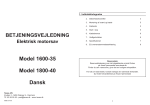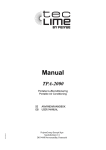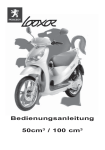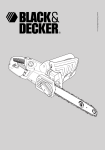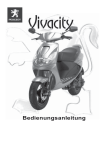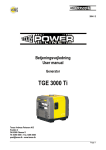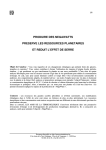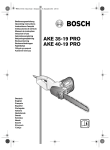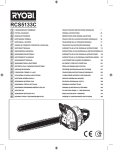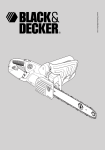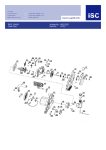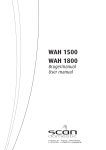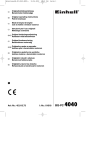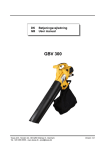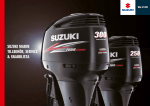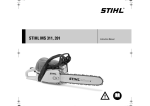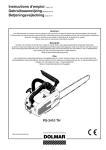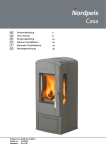Download Manual
Transcript
1. Indholdsfortegnelse 2. Sikkerhedsforskrifter 3 3. Før start - brændstof og kædeolie 5 4. Choker 5 5. Start 5 BETJENINGSVEJLEDNING 6. Stop 6 7. Kædebremse 6 Benzin motorsav 8. Automatisk smøring 6 9. Brændstoffilter 6 AC / CS 350 AC / CS 380 10. Luftfilter 7 11. Tændrør 7 12. Vedligeholdelse 7 13. Opbevaring 9 14. Fejlfinding 9 15. Specifikationer 10 16. EU Overensstemmelseserklæring 11 Dansk Reservedele Reservedelstegning over det pågældende produkt findes på vores hjemmeside www.texas.dk Finder du selv varenumre, giver det en hurtigere ekspedition. Texas A/S Knullen 2 - 5260 Odense S - Danmark Tlf. 63 95 55 55 - [email protected] - www.texas.dk 9096-31A117 For køb af reservedele, kontakt venligst din nærmeste forhandler. Du finder forhandlerliste på Texas' hjemmeside. 2 2. Sikkerhedsforskrifter - Læs denne betjeningsvejledning grundigt, dermed du forstår og kan følge alle sikkerhedsforskrifter og betjeningsfunktioner fuldstændigt, før du går i gang med at arbejde med maskinen. - Arbejd kun med træfældning, hvis du er specielt uddannet til det. - Alle reparationer, som ikke er beskrevet i denne betjeningsvejledning, må kun udføres af specialuddannet personale på et autoriseret serviceværksted. Brug af forkert værktøj kan ødelægge din kædesav. - Kædebremsen er monteret for at beskytte mod "kast", som er en hurtig opadgående bevægelse i sværdet. Dette kan forekomme, hvis sværdspidsen rammer fremmedlegemer. Det er derfor vigtigt, at du er opmærksom på, om kædebremsen virker. - Børn må ikke bruge saven. - Hvis du føler dig syg, træt eller har indtaget alkohol eller medicin, skal du undlade at arbejde med motorsaven. - Brug altid sikkerhedsfodtøj, sikkerhedsbukser, beskyttelsesbriller, høreværn og sikkerhedshjelm. - - Brændstof må kun påfyldes udendørs. Aftør spildt brændstof før maskinen startes. Gå mindst 3 meter væk fra brændstofbeholderen og påfyldningsstedet før kædesaven startes. Fyld aldrig brændstof på en varm motor, vent til den er afkølet. Hold kædesaven fast med begge hænder i håndtaget, og hold den så tæt ind til dig, at du hele tiden har kontrol over den. Som vist på tegning. - Lad motorkroppen ligge mod træet, mens du saver. - - Sørg for, at eventuelle tilskuere er mindst 10 meter fra det sted, hvor du starter / arbejder med kædesaven. Undgå at save med sværdspidsen og kontroller at sværdspidsen ikke rammer noget, mens du saver. - Sav ikke med kædesaven over skulderhøjde. - Begynd aldrig at save før: - Følg vejledningen for filning og vedligeholdelse i denne betjeningsvejledning. - Start ikke kædesaven uden at have sværd og kæde monteret, da motoren kan komme op i et højere omdrejningstal end koblingen og kædestop er beregnet til. Dette kan medføre skade på både maskine og bruger. - Arbejdsområdet er ryddet. - Du har sikkert fodfæste. - Du har vurderet, hvor træet vil lande. - Hold om kædesavens håndtag med begge hænder og med tommelfingeren under forreste bøjle. - Hold kædesaven væk fra kroppen. - Før du starter kædesaven, skal du kontrollere, at kæden ikke er i kontakt med noget. - Stop altid motoren, når du stiller kædesaven fra dig. Sørg for at sværd og kæde vender bagud, når du bærer maskinen. Pas på du ikke brænder dig på den varme udstødning. - Undersøg din kædesav for slidte, løstsiddende eller ødelagte dele, spænd bolte og møtrikker efter. Maskinen bør ikke anvendes, før den er i korrekt og driftsmæssig stand. Vær sikker på at kæden altid står stille, når motoren går i tomgang. - Vær ekstra forsigtig, når du saver i buske og små træer. Små grene kan gribe fat i kæden og blive slynget imod dig eller få dig til at miste balancen. - Sørg for at håndtagene er rene, og at der ikke er rester af olie og benzin. - Arbejd kun med kædesaven udendørs. 3 4 3. Før start - brændstof og kædeolie 6. Stop Bland blyfri benzin oktan 95 og godkendt halvsyntetisk 2-takts olie. Brug den medfølgende dunk på 95 ml til de første 2,5 liter benzin. Dette giver en 5% blanding. Efterfølgende anbefales Texas Motex 2 TX med en 2% blanding. Hvis der anvendes andre typer olier anbefales en blanding på 4% eller du kan følge olieproducentens anvisninger. ADVARSEL Undgå åben ild i nærheden af påfyldningsstedet. Vær opmærksom på om der er snavs eller vand i benzinen. Opbevar altid benzin i en ren og godkendt dunk. Brug altid kædeolie til smøring af sværd og kæde. Texas anbefaler Klingtex kædeolie viskositet 125. 4. Choker Chokeren har 3 positioner. Fig. 9A A A - Ingen choker B - Halv choker C - Fuld choker 5. Start 5 Fig. 9B 7. Kædebremse Test kædebremsen på følgende måde. B A 1. Placer saven på et fast underlag. C 2. Start motoren. 3. Hold med højre hånd på bagerste gashåndtag(A). Fig 11 Fig. 11 4. Hold med venstre hånd på forreste håndtag(B). Fig 11 5. Giv 1/3 gas og aktiver kædebremsen(C). Fig 11 6. Kæden skal øjeblikkeligt stoppe. Når den stopper, frigiv gassen. 7. Hvis kædebremsen virker, stop maskinen og placer kædebremsehåndtaget i deaktiveret position. Hvis kæderbremsen ikke virker, kontakt din forhandler. Kædesaven er udstyret med et automatisk smøresystem, der sikrer at kæden altid er smurt optimalt. Det er dog en forudsætning, at der altid er olie på maskinen. Bemærk Texas anbefaler Klingtex kædeolie viskositet 125. C F D 8. Automatisk smøring B 1. Sæt tændingskontakten(D) på "start". Fig 9B 2. Sæt chokeren på fuld choker. 3. Tryk på karburatorens primer(F) 10 gange. Fig 9D 4. Lås gashåndtaget(A). Fig 10A 5. Placer kædesaven på et fast underlag som vist. Træk hurtigt 4 gange i startsnoren. Fig 10B 6. Flyt chokeren til halv choker. Fig 10C 7. Træk i startersnoren et par gange, saven skulle nu starte. Fig 10D 8. Frigør gassen hurtigst muligt. Fig 10E 9. Flyt chokeren til ingen choker. Fig 10F Hvis saven er varm, behøves der ikke choker til start. 1. Slip gashåndtaget. 2. Lad motoren gå i tomgang. 3. Tryk maskinens tændingskontakt på "stop". Fig 9B D Påfyld olie her 9. Brændstoffilter Fig. 9D Fig. 9B A D Fig. 10A B Fig. 10B Fig. 10C F E Fig. 10D Fig. 10E Fig. 10F 1. 2. 3. 4. 5. 6. Fjern brændstoftankens dæksel. Dræn al brændstof fra tanken. Form en krog ud af et stykke ståltråd. Grib fat i brændstoffilteret i tanken med krogen. Drej filteret af og installer et nyt filter. Indsæt filter / slange i tanken igen, vær opmærksom på at det kommer rigtig på plads i bunden af tanken. 7. Fyld brændstof på igen. Fig. 19 A ADVARSEL Brug aldrig maskinen uden brændstoffilter. Det kan skade maskinens indre dele og forkorte maskinens levetid. 6 10. Luftfilter Rens luftfilteret på følgende måde. 1. Fjern topdækslet(A). 2. Tag luftfilteret(B) ud af holderen(C). 3. Rens filteret i varmt sæbevand. Skyl efter med rent vand. 4. Lad filteret tørre fuldstændig, kom nogle dråber 2-taktsolie på filteret. Tryk evt. overskydende olie ud. 5. Monter filteret og topdækslet igen. Fig. 18 B C A Kæde. Kæden bør files jævnligt for at opnå det bedste resultat. 1. Sørg for at sværdet er spændt godt fast. 2. Brug en 4,0 mm" fil. 3. Fil alle tænderne med 3-4 strøg, så de er ens, som vist på tegningen. 4. Det er nødvendigt jævnligt at efterse højden af tænderne, hvis de er for høje, bør de files ned. Fig. 25 Fig. 26 Fig. 24 11. Tændrør Tændrøret skal holdes rent for at virke optimalt. Tjek tændrøret på følgende måde. 1. Sæt maskinens tændingskontakt på "stop". 2. Tag tændrørshætten af tændrøret. 3. Børst snavs og savsmuld væk omkring tændrøret. 4. Skru det ud med en tændrørsnøgle. 5. Tjek, rens eller udskift hvis nødvendigt. 6. Monter tændrøret sikkert og placer tændrørshætten på tændrøret igen. Fig. 21 B A 12. Vedligeholdelse Smørehul. Afmonter sværd og kontroller om smørehullet er stoppet med savsmuld eller snavs. Smørehul på maskinen Sværd. Rens næsehjul og løbegang for snavs. Vend evt. sværdet for at fordele sliddet. Et slidt sværd kan være farligt at anvende, og bør derfor udskiftes. Skift af kæde. A C 1. Afmonter sidedækslet. 2. Læg kæden rundt om kædehjulet på sværdet. Når kæden har godt fat i Fig. 3B Fig. 3A B Fig. 3C kædehjulet, sættes sværdet ind på motorenheden, og kæden lægges i F sværdet. Fig 3D / 3B D a. Vær opmærksom på, at smørehullet i sværdet er ud for smørehullet i maskinen. Fig 3A / Fig 6 E G Fig. 3D Fig. 3B 3. Vær opmærksom på at kæden vender Fig. 5 den rigtige vej. Fig 4A B 4. Monter sidedækslet. 5. Spænd møtrikkerne til med fingrene. 6. Løft i sværdspidsen, og stram kæden op ved hjælp af strammerbolten, indtil kæden netop berører sværdets underkant. Fig 5 7. Kæden skal være så stram at man lige netop kan løfte drivleddet fri af sporet i sværdet. 8. Spænd sværd og sidedæksel forsvarligt til. Hvis du er i tvivl, bør du kontakte din forhandler. Fig. 27 7 Fig. 28 8 15. Specifikationer Vedligeholdelsesintervaller: Del Skruer / bolte Luftfilter Brændstoffilter Sværd / drivhjul Tændrør Brændstofslange Kædebremse Efter hver brug X Tjek / stram Rens / udskift Udskift Rens Rens / juster/ udskift Tjek Udskift Tjek Udskift Hver 10 køretime Hver 20 køretime X X X X X Hvis nødvendigt X Hvis nødvendigt 13. Opbevaring 1. 2. 3. 4. 5. 6. 7. 8. Tøm brændstoftanken. Start maskinen og lad den køre til alt brændstof er brugt. Lad maskinen køle af. Skru tændrøret af. Hæld 1 teskefuld 2-taktsolie i tændrørshullet. Træk roligt i startsnoren 2-3 gange, dermed olien bliver fordelt i maskinen. Skru tændrøret forsvarligt på, og sæt tændrørshætten på igen. Opbevar motorsaven et tørt sted. Model Boring / slaglængde Tænding Elektrodeafstand Tændrør Brændstof Tankindhold Smøring Anti-vibration Vægt Sværdtype Kædebremse Håndskarm Gaslås Kædefanger Barksted Kæde Varenummer: AC / CS 350 AC / CS 380 35cc 38cc Elektronisk 0,6 DENSO W22MP-US Blyfri 95 oktan, olieblandet, 2-takt 0,29 L Klingtex kædeolie Viskositet 125 Ja 5,5 kg 5,6 kg 14” / 35cm 16” / 40cm Ja Ja Ja Ja Ja 49 Led 54 Led 40-109 40-115 14. Fejlfinding PROBLEM Starter, men vil ikke køre. Starter ikke. ÅRSAG Forkert startprocedure. Forkert karburatorjustering. Motoren starter, men maskinen har intet kraftoverskud. Defekt tændror. Brændstoffilter stoppet. Forkert chokerposition Snavset gnistfang Snavset luftfilter Forkert karburatorjustering. Maskinen har intet kraftoverskud Kører uregelmassigt. Ryger meget Forkert karburatorjustering. Forkert / snavset tændrør. Forkert karburatorjustering. Forkert karburatorjustering. 9 LØSNING Følg instruktionerne. Juster karburator. Kontakt et service værksted. Rens eller udskift. Rens eller udskift. Sæt choker på KØR Rens gnistfang. Kontakt et service varksted. Rens luftfilter Juster karburator. Kontakt et service værksted. Juster karburator. Kontakt et service værksted. Udskift eller rens tændrør. Juster karburator. Kontakt et service værksted. Brug den foreskrevne 2-takts blanding. 10 EU overensstemmelseserklæring EU-importør Texas Andreas Petersen A/S Erklærer herved at materiel: • Motorsav AC31A114TD (AC / CS 350) 35 cc • Motorsav AC31A116TD (AC / CS 380) 38 cc er fremstillet i overensstemmelse med følgende direktiver: 89/392/EC Maskindirektivet 89/336/EEC EMC direktivet Materiellet er udført i henhold til følgende standarder: EN 292-2 1991 og EN 608 Texas Andreas Petersen A/S Knullen 2 5260 Odense S BETJENINGSVEJLEDNING Bensin motorsåg AC / CS 350 Verner Hansen Direktør AC / CS 380 18.08.2004 Svensk Texas A/S Knullen 2 - 5260 Odense S - Danmark Tlf. 63 95 55 55 - [email protected] - www.texas.dk 11 12 1. Innehållsförteckning 2. Säkerhetsföreskrifter 2. Säkerhetsföreskrifter 14 3. Før start –bränsle och kedjeolja 16 4. Choke 16 5. Start 16 6. Stopp 17 7. Kedjebroms 17 8. Automatisk smörjning 17 9. Bränslefilter 17 - Läs denna bruksanvisning noggrant, så att du förstår och kan följa alla säkerhetsföreskrifter och betjäningsfunktioner innan du börjar arbeta med maskinen. - Låt inte barn använda sågen. - Använd aldrig motorsågen om du är sjuk, trött, har druckit alkohol eller har tagit medicin. - Använd alltid personlig skyddsutrustning såsom; skyddsskor, säkerhetsbyxor, skyddsglasögon, hörselskydd samt skyddshjälm. - Påfyllning av bränsle får endast ske utomhus. Spillt bränsle torkas av innan maskinen startas. Gå minst tre meter bort från bränslebehållaren och påfyllningsplatsen innan kedjesågen startas. Fyll aldrig på bränsle när motorn är varm, utan vänta tills den har blivit kall. - Se till att inga obehöriga finns inom arbetsområdet (minst 10 meter från den plats där du arbetar). - Börja aldrig såga innan: 10. Luftfilter 18 11. Tändrör 18 12. Underhåll 18 13. Förvaring 20 - Fatta tag om kedjesågens handtag med båda händer och med tummen under den främre ringen. 14. Felsökning 20 - Håll kedjesågen bort från kroppen. 15. Specifikationer 21 - Innan du startar kedjesågen, skall du kontrollera att kedjan inte kan gripa tag i något. 16. EC Överenskommelseförklaring 22 - Stoppa alltid motorn när du ställer kedjesågen ifrån dig. Bär motorsågen med svärd och kedja vända bakåt. Se upp så att du inte bränner dig på det varma utblåsröret. - Undersök din kedjesåg för slitna, lösa eller förstörda delar, och dra åt bultar och muttrar om så behövs. Maskinen bör inte användas innan den är i korrekt och driftsmässigt skick. Var säker på att kedjan alltid står stilla när motorn går på tomgång. - Var extra försiktig när du sågar i buskar och små träd. Små grenar kan gripa tag i kedjan och slungas mot dig eller få dig att tappa balansen. - Se till att handtagen är rena, och att det inte finns rester av olja och bensin. - Arbeta endast med kedjesågen utomhus. - Arbeta endast med trädfällning om du är speciellt utbildad för det. Reservdelar Reservdelsförteckning för produkten finns på vår hemsida www.texas.dk Om du själv tar fram varunumret, går det fortare att hitta rätt reservdel. - du står stadigt. - du har planerat en flyktväg vid fallande träd. Kontakta din närmaste återförsäljare om du vill köpa reservdelar. 13 - arbetsområdet har städats. 14 3. Før start - Bränsle och kedjeolja - Alla reparationer som inte beskrivs i denna bruksanvisning får endast utföras af specialutbildad personal på en auktoriserad serviceverkstad. Om fel verktyg används, kan din kedjesåg förstöras. - Kedjebromsen är monterad för att skydda mot "kast", som är en snabbt uppåtgående rörelse i svärdet. Detta kan förekomma om svärdspetsen träffar ett föremål. Därför är det viktigt att du är uppmärksam på om kedjebromsen inte fungerar. Blanda blyfri bensin (oktan 95) och godkänd halvsyntetisk 2-taktsolja. Vanlig motorolja får inte användas. Använd den medföljande dunken på 95 ml till de första 2,5 liter bensin. Detta ger en 5 % blandning. Efterföljande rekommenderas Texas Motex 2 TX med en 2 % blandning. Om andra oljetyper används, rekommenderas en 4 % blandning. OBSERVERA Gällande blandningsförhållanden, bör oljeproducentens anvisningar alltid följas. Använd endast originala reservdelar. - Håll fast kedjesågen med båda händer, och håll den så tätt intill dig att du hela tiden har kontroll över den. - Låt motorkroppen ligga mot trädet medan du sågar. - Undvik att såga med svärdspetsen, och kontrollera att svärdspetsen inte träffar något medan du sågar. Använd alltid kedjeolja till smörjning av svärd och kedja. Texas rekommenderar Kedjeolja viskositet 125. - Såga inte med kedjesågen över axelhöjd. 4. Choke - Följ anvisningen för filning och underhåll i denna bruksanvisning. - Start aldrig motorsågen uden at have monteret svärd och kedja. Choken har tre lägen: A - Ingen choke B - Halv choke C - Full choke VARNING Undvik öppen eld i närheten av påfyllningsplatsen. Kontrollera så att det inte finns smuts eller vatten i bensinen. Förvara alltid bensin i en ren och godkänd dunk Fig. 9A A B C 5. Start 1. Flytta tändningskontakten(D) till "start". Fig. 9B 2. Flytta choken till läget full choke. 3. Tryck 10 gånger på förgasarens primer(F). Fig. 9D 4. Lås gashandtaget(A). Fig. 10A 5. Placera kedjesågen på ett stadigt underlag, som på ritningen. Dra snabbt fyra gånger i startsnöret. Fig. 10B 6. Flytta choken till halv choke. Fig. 10C 7. Dra i startsnöret några gånger, och sågen startar. Fig. 10D 8. Frigör gasen så fort som möjligt. Fig. 10E 9. Flytta choken till ingen choke. Fig. 10F Om sågen är varm, behövs ingen choke för att starta. 15 16 F Fig. 9D D Fig. 9B A D Fig. 10A B Fig. 10B Fig. 10C F E Fig. 10D Fig. 10E Fig. 10F 10. Luftfilter 6. Stopp 1. Släpp gashandtaget. 2. Låt motorn gå på tomgång. 3. Med tändningskontakten trycks det på "stopp". Fig. 9B D Fig. 9B 7. Kedjebroms Kontrollera kedjebromsens funktion på följande sätt: B A C 1. Placera sågen på ett stadigt underlag. 2. Starta motorn. 3. Fatta tag om det bakre gashandtaget(A) med höger Fig. 11 hand. Fig. 11 4. Fatta tag om det främre handtaget(B) med vänster hand. Fig. 11 5. Ge 1/3 gaspådrag, och aktivera kedjebromsen (C). Fig. 11 6. Kedjan skall stoppa omedelbart. När den stoppar, frigör då gasen. 7. Om kedjebromsen fungerar, så stoppa maskinen och placera kedjebromshandtaget i deaktiverat läge. 8. Automatisk smörjning Kedjesågen är utrustad med ett automatiskt smörjningssystem, som säkrar att kedjan alltid är smord. Det förutsätter att det alltid finns olja i maskinen. Texas rekommenderar Klingtex viskositet 125. Påfyld olie her 9. Bränslefilter 1. 2. 3. 4. Ta bort bränsletankens kåpa. Tappa ur allt bränsle ur tanken. Forma en krok av en bit ståltråd. Grip tag i bränslefiltret som sitter i tanken med kroken. 5. Vrid av filtret, och lägg i ett nytt filter. 6. Sätt i filtret/slangen i tanken igen. Se till att filtret/slangen sätts tillbaks korrekt i tankens botten. 7. Fyll på med bränsle igen. Fig. 19 Fig. 18 B C A 11. Tändstift Tändstiftet skall hållas rent, för att kunna fungera Fig. 21 optimalt. Kontrollera tändstiftet på följande sätt: B 1. tta maskinens tändningskontakt till "stopp". 2. av tändstiftskåpan från tändstiftet. A 3. Borsta bort smuts och sågspån runt tändstiftet. 4. Skruva ut det med en tändstiftsnyckel. 5. Kontrollera, rengör eller byt ut vid behov. 6. Montera tändstiftet säkert, och sätt tillbaks tändstiftskåpan på tändstiftet igen. 12. Underhåll Smörjhål. Demontera svärdet och kontrollera om smörjhålet är igenproppat med sågspån eller smuts. A VARNING Använd aldrig maskinen utan bränslefilter. Det kan skada maskinens inre delar och förkorta motorns livslängd. 17 Rengör luftfiltret på följande sätt: 1. Ta av toppkåpan(A). 2. Ta ut luftfiltret(B) ur hållaren (C). 3. Rensa filtret i varmt vatten med lite diskmedel. Skölj med rent vatten. 4. Låt filtret torka helt och häll några droppar tvåtaktsolja på filtret. Avlägsna eventuellt överskott av olja. 5. Montera filtret och höljet igen. Smörjhål i maskinen Svärd. Rengör noshjul och dragsko från smuts. Vänd ev. svärdet för att fördela slitaget. Ett utslitet svärd kan vara farligt att använda, och bör därför bytas ut. 18 Fig. 27 Fig. 28 Underhåll intervallar: Kedja. Kedjan bör filas ofta för bästa resultat. 1. Se till att svärdet är sträckt ordentligt. 2. änd en 4.0mm" fil. 3. Fila alla tänder med 3–4 drag, så att de är lika långa. Se ritning. 4. Det är viktigt att undersöka tändernas höjd regelbundet. Om de är för höga, bör de filas ned. Fig. 25 Fig. 26 Del Skruvar/bultar Luftfilter Bränslefilter Svärd / drivhjul Tändstift Bränsleslang Kedjebroms Efter varje användning X Kontrollera/dra åt Rengör/byt ut Byt ut Rengör Rengör/justera/byt ut Kontrollera Byt ut Kontrollera Byt ut Var 10:e körtimme Var 20:e körtimme X X X X X Vid behov X Vid behov Fig. 24 13. Förvaring Skift av kedja. 1. Lossa muttrarna och ta bort kåpan. A C 2. g kedjan över svärdets kedjehjul. När kedjan har fått ordentligt fatt i kedjehjulet, placeras svärdet i motorenheten, och kedjan läggs an mot Fig. 3B Fig. 3A B Fig. 3C svärdet. Fig. 3D/3B Kontrollera att smörjhålet i svärdet sitF D ter på samma ställe som smörjhålet i maskinen. Fig. 3A/Fig. 6 3. Kontrollera att kedjan vänder åt rätt E G Fig. 3D Fig. 3B håll. Fig. 4A Fig. 5 4. Sätt tillbaks kåpan. B 5. Dra åt muttrarna för hand. 6. Lyft svärdspetsen, och spänn kedjan med en kedjespännare, tills kedjan nätt och jämt nuddar svärdets underkant. Fig. 5 7. Kedjan skall vara så pass sträckt att det nätt och jämt går att lyfta drivlänken ur svärdets spår. 8. Spänn svärd och kåpa ordentligt. Om du är osäker, bör du kontakta din återförsäljare. 1. 2. 3. 4. 5. 6. 7. 8. Tappa ur bränsle ur tanken. Starta maskinen och låt den köra tills allt bränsle har använts. Låt maskinen bli kall. Skruva av tändstiftet. Häll ner 1 tesked 2-takssolja i tändstiftshålet. Dra lugnt i startsnöret 2-3 gånger så att oljan fördelas i maskinen. Skruva på tändstiftet ordentligt, och sätt på tändstiftskåpan igen. Förvara motorsågen på en torr plats. 14. Felsökning PROBLEM Startar, men vill inte köra. Startar inte. ORSAK Fel startprocedur. Fel förgasarjustering. Motorn startar, men maskinen har inget kraftöverskott. Defekt tändstift. Bränslefiltret har stoppat. Fel chokeläge. Smutsig gnistfångare. Smutsigt luftfilter. Fel förgasarjustering. Maskinen har inget kraftöverskott. Kör oregelbundet. Ryker mycket. Fel förgasarjustering. Fel/smutsigt tändstift. Fel förgasarjustering. Fel bränsleblandning. 19 20 ATGÄRDER Följ anvisningarna. Justera förgasaren. Kontakta en serviceverkstad. Rengör eller byt ut. Rengör eller byt ut. Sätt choke på KÖR Rengör gnistfångaren. Kontakta en serviceverkstad. Rengör luftfiltret. Justera förgasaren. Kontakta en serviceverkstad. Justera förgasaren. Kontakta en serviceverkstad. Byt ut eller rengör tändstiftet. Justera förgasaren. Kontakta en serviceverkstad. Använd den föreskrivna 2taktsblandningen. 15. Specifikationer EC Överenskommelseförklaring Modell Borrning/slaghöjd Tändning Elektrodavstånd Tändstift Bränsle Tankvolym Smörjning Antivibrationssystem Vikt Svärdlängd Kedjebroms Handskydd Gaslås Kedjefångare Barkstöd Kedja Varunummer: AC / CS 350 AC / CS 380 35cc 38cc Elektronisk 0,6 DENSO W22MP-US Blyfritt 95 oktan, oljeblandat, 2-takt 0,29 L Automatisk Ja 5,5 kg 5,6 kg 14” / 35cm 16” / 40cm Ja Ja Ja Ja Ja 49 led 54 Led 40-109 40-115 EU-importør Texas Andreas Petersen A/S Undertecknad förklarar på företagets vägnar att: • Motorsåg AC31A114TD (AC / CS 350) 35 cc • Motorsåg AC31A116TD (AC / CS 380) 38 cc Uppfyller EU - direktiver: 89/392EC 89/336/EEC Maskindirektiv EMC direktiv Materiellet er udført i henhold til følgende standarder: EN 292-2 1991 og EN 608 Texas Andreas Petersen A/S Knullen 2 5260 Odense S Danmark Verner Hansen Adm. Direktør 18.08.2004 21 22 GENERAL SAFETY RULES Meaning of symbols marked on the product Read the user manual before using the machine Wear dust mask to protect against dust Wear safety goggles to protect your eyes Wear glove to protect your hands Wear ear protector to protect against noise Wear safety boots to protect agains electric shock WARNING! When using gas tools, basic safety precautions, including the following, should always be followed to reduce the risk of serious personal injury and/or damage to the unit. USER MANUAL Read all these instructions before operating this product and save these instructions. 1. Gasoline Chain Saw AC / CS 350 AC / CS 380 English DO NOT operate a chain saw with one hand! Serious injury to the operator, helpers, bystanders, or any combination of these persons may result from onehanded operation. A chain saw is intended for twohanded use. 2. DO NOT operate a chain saw when you are fatigued. 3. Use safety footwear, snug-fitting clothing, protective gloves, and eye, hearing and head protection devices. 15. Operate the chain saw only in well-ventilated areas. 16. DO NOT operate a chain saw in a tree unless you have been specifically trained to do so. 17. All chain saw service, other than the items listed in the user manual safety and maintenance instructions, should be performed by competent chain saw service personnel. 18. When transporting your chain saw, use the appropriate guide bar scabbard. 4. Use caution when handling fuel. Move the chain saw at least 10 feet (3m) from the fueling point before starting the engine. 19. DO NOT operate your chain saw near or around flammable liquids or gases whether in or out of doors. An explosion and/or fire may result. 5. DO NOT allow other persons to be near when starting or cutting with the chain saw. Keep bystanders and animals out of the work area. 20. Do not tank fuel, oil or lubrication when the engine of chain saw is running. 6. DO NOT start cutting until you have a clear work area, secure footing, and a planned retreat path from the falling tree. 7. Keep all parts of your body away from the saw chain when the engine is running. 8. Before you start the engine, make sure that the saw chain is not contacting anything. 9. Carry the chain saw with the engine stopped, the guide bar and saw chain to the rear, and the muffler away from your body. 21. USE THE RIGHT TOOL: Cut wood only. Do not use the chain saw for purposes for which it was not intended. For example, do not use the chain saw for cutting plastic, masonry, or nonbuilding materials. NOTE: This appendix is intended primarily for the consumer or occasional user. These models are intended for infrequent use by homeowners, cottagers, and campers, and for such general applications as clearing, pruning, cutting firewood, etc. They are not intended for prolonged use. If the intended use involves prolonged periods of operation, this may cause circulatory problems in the user’s hands due to vibration. It may be appropriate to use a saw having an anti-vibration feature such as the models covered in this manual with the suffix Anti-Vibration. 10. DO NOT operate a chain saw that is damaged, improperly adjusted, or not completely and securely assembled. Be sure that the saw chain stops moving when the throttle control trigger is released. 11. Shut off the engine before setting the chain saw down. 12. Use extreme caution when cutting small size brush and saplings because slender material may catch the saw chain and be whipped toward you or pull you off balance. Texas A/S Knullen 2 - 5260 Odense S - Danmark Tlf. 63 95 55 55 - [email protected] - www.texas.dk 23 13. When cutting a limb that is under tension, be alert for springback so that you will not be struck when the tension in the wood fibers is released. 14. Keep the handles dry, clean, and free of oil or fuel mixture. 24 KICKBACK SAFEY PRECAUTIONS IMPORTANT SAFETY Kickback may occur when the nose or tip of the guide bar touches an object, or when the wood closes in and pinches the saw chain in the cut. If the bar tip contacts, it may cause a lightning-fast reverse reaction, kicking the guide bar up and back towards the operator. Pinching the saw chain along the top of the guide bar may push the guide bar rapidly back towards the operator. Either of these reactions may cause you to lose control of the saw, which could result in serious personal injury. Do not rely exclusively upon the safety devices built into your saw. As a chain saw user, you should take several steps to keep your cutting jobs free from accident or injury. 1. With a basic understanding of kickback, you can reduce or eliminate the element of surprise. Sudden surprise contributes to accidents. 2. Keep a good firm grip on the saw with both hands, the right hand on the rear handle, and the left hand on the front handle, when the engine is running. Use a firm grip with thumbs and fingers encircling the chain saw handles. A firm grip will help you reduce kickback and maintain control of the saw. Don’t let go. Your Chain Saw is provided with a safety label located on the chain brake lever/hand guard. This label, along with the safety instructions on these pages, should be carefully read before attempting to operate this unit. 3. Make sure that the area in which you are cutting is free from obstructions. Do not let the nose of the guide bar contact a log, branch, or any other obstruction which could be hit while you are operating the saw. 4. Cut at high engine speeds. 5. Do not overreach or cut above shoulder height. 6. Follow manufacturer’s sharpening and maintenance instructions for the saw chain. 7. Only use replacement bars and chains specified by the manufacturer or the equivalent. NOTE: Low-kickback saw chain is chain that has met the kickback performance. • AC / CS 350 35cc Y Y Y Y 25 A A B Fig. 2B Fig. 2A BEWARE OF: ROTATIONAL KICKBACK (Fig. 2A) A = Kickback path B = Kickback reaction zone C THE PUSH (PINCH KICKBACK) AND PULL REACTIONS (Fig. 2B) A = Pull B = Solid objects C = Push KICKBACK may occur when the NOSE or TIP of the guide bar touches an object, or when wood closes in and pinches the saw chain in the cut. Tip contact in some cases may cause a lightning-fast reverse reaction, kicking the guide bar up and back toward the operator. PINCHING the saw chain along the BOTTOM of the guide bar may PULL the saw forward away from the operator. PINCHING the saw chain along the TOP of the guide bar may PUSH the guide bar rapidly back toward the operator. Any of these reactions may cause you to lose control of the saw, which could result in serious personal injury. DANGER! BEWARE OF KICKBACK! WARNING: Kickback can lead to dangerous loss of control of the chain saw and result in serious or fatal injury to the saw operator or to anyone standing close by. Always be alert. Rotational kickback and pinch-kickback are major chain saw operational dangers and the leading cause of most accidents. AC / CS 380 38cc 1.2 Kw 10mm 1.3mm 2,800-3,300 min-1 8,000 min-1 296 cc 180 cc Y 5,5 kg 5,6 kg HOW TO READ SYMBOLS AND COLORS (FIG. 1) GREEN RECOMMENDED Recommended cutting procedure. WARNING 1. Beware of kick back. 1 3 2. Do not attempt to hold saw with one hand. 4 3. Avoid bar nose contact. 2 RECOMMENDED 4. Hold Saw properly with both Fig. 1 hands. • B A WARNING: RED Used to warn that an unsafe procedure should not be performed. SPECIFICATIONS Model Engine Displacement Maximum Shaft Brake Power Chain Pitch Chain Gauge Idel Speed Speed in Max. power Fuel Capacity Oil Capacity Anti-vibration Net Weight Cutting Length 14” 16” Chain Brake Clutch Automatic Chain Oiler Lowe KickBack Chain A ASSEMBLY INSTRUCTIONS • TOOLS FOR ASSEMBLY • You will need these tools to assemble your chain saw: 1. Combination wrench-screwdriver (contained in your user’s kit). 2. Heavy duty work gloves (user supplied). • GUIDE BAR / SAW CHAIN / CLUTCH COVER INSTALLATION WARNING: Always wear protective gloves when handling chain. ASSEMBLY REQUIREMENTS TO INSTALL GUIDE BAR: To ensure the bar and chain receive oil, ONLY USE THE ORIGINAL STYLE BAR with the oil passage hole (A) as illustrated above (Fig. 3A). 1. Make sure the Chain brake lever is pulled back into the DISENGAGED position (Fig. 3B) 2. Remove the 2 bar retaining nuts (B). Loosen the 2 screws at the rear of the clutch cover (C). Remove the cover (Fig. 3C). 3. Using a screwdriver, run the adjustment screw (D) COUNTERCLOCKWISE until the TANG (E) (projecting prong) is to the end of its travel toward the clutch drum and sprocket (Fig. 3D). 4. Place the slotted end of the guide bar over the 2 bar bolts (F). Position the bar so that the adjustment TANG fits into the lower hole (G) on the guide bar (Fig. 3E). WARNING: DO NOT start saw engine until unit is properly prepared. Your new chain saw will require adjustment of chain, filling the fuel tank with correct fuel mixture and filling the oil tank with lubricating oil before the unit is ready for operation. Read the entire user manual before attempting to operate your unit. Pay particular attention to all safety precautions. Your user manual is both a reference guide and handbook provided to furnish you with general information to assemble, operate and maintain your saw. 26 2. A Fig. 3A After making adjustment, and while still holding nose of bar in the uppermost position, tighten the bar retaining nuts securely. Chain has proper tension when it has a snug fit all around and can be pulled around by gloved hand. NOTE: If chain is difficult to rotate on guide bar or if it binds, too much tension has been applied. This requires minor adjustment as follows: A. Loosen the 2 bar retaining nuts so they are finger tight. Decrease tension by turning the bar adjustment screw COUNTERCLOCKWISE slowly. Move chain back and forth on bar. Continue to adjust until chain rotates freely, but fits snugly. Increase tension by turning bar adjustment screw CLOCKWISE. B. When saw chain has proper tension, hold nose of bar in the uppermost position and tighten the 2 bar retaining nuts securely. C Fig. 3B Fig. 3C F D E Fig. 3D B G Fig. 3B TO INSTALL SAW CHAIN: 1. Spread chain out in a loop with cutting edges (A) pointing CLOCKWISE around loop (Fig. 4A). 2. Slip the chain around the sprocket (B) behind the clutch (C). Make sure the links fit between the sprocket teeth (Fig. 4B). 3. Guide the drive links into the groove (D) and around the end of the bar (Fig. 4B). NOTE: The saw chain may droop slightly on the lower part of bar. This is normal. 4. Install the clutch cover and tighten the 2 screws. Make sure the chain does not slip off of the bar. Install the 2 nuts hand tight and follow tension adjustment instructions in Section SAW CHAIN TENSION ADJUSTMENT. NOTE: The guide bar retaining nuts are installed only hand tight at this point because saw chain adjustment is required. Follow instructions in Section SAW CHAIN TENSION ADJUSTMENT. Fig. 4A A • FUEL AND LUBRICATION WARNING: Never use straight gasoline in your unit. This will cause permanent engine damage and void the manufacturer’s warranty for that product. Never use a fuel mixture that has been stored for over 90 days. Gasoline and Oil Mix 40:1 WARNING: If 2-cycle lubricant other than Texas Custom Lubricant is to be used, it must be a premium grade oil for 2-cycle air cooled engines mixed at a 40:1 ratio. Do not use any 2-cycle oil product with a recommended mixing ratio of 100:1. If insufficient lubrication is the cause of engine damage, it voids the manufacturer’s engine warranty for that occurrence. • 1 U.S. Gal. 5 Liters 1 lmp. Gal. Mixing Procedure MIXING FUEL Mix fuel with Texas brand 2 cycle oil in an approved container. Use mixing table for correct ratio of fuel to oil. Shake container to ensure thorough mix. • Texas 40:1 Ratio Custom Lubricant 3.2 oz. 95ml (cc) 4.3 oz. 125ml (cc) 4.3 oz. 125ml (cc) 40 Parts Gasoline to 1 part Lubricant 1ml = 1cc RECOMMENDED FUELS Some conventional gasolines are being blended with oxygenates such as alcohol or an ether compound to meet clean air standards. Your Texas engine is designed to operate satisfactorily on any gasoline intended for automotive use including oxygenated gasolines. warranty. Fig. 5 Oil Only FUEL MIXING TABLE GASOLINE WARNING: Lack of lubrication voids engine CAUTION: If saw chain is TOO LOOSE or TOO TIGHT, the sprocket, bar, chain, and crankshaft bearings will wear more rapidly. Study Fig. 6 for information concerning correct cold tension (A), correct warm tension (B), and as a guide for when saw chain needs adjustment (C). • CHAIN AND BAR LUBRICATION Always refill the chain oil tank each time the fuel tank is refilled. We recommend using Texas Chain, Bar and Sprocket Oil, which contains additives to reduce friction and wear and to assist in the prevention of pitch formation on the bar and chain. OPERATING INSTRUCTIONS B SAW CHAIN TENSION ADJUSTMENT A Proper tension of saw chain is extremely important and must be checked before starting, as well as during any cutting operation. Taking the time to make needed adjustments to the saw chain will result in improved cutting performance and prolonged chain life. TO ADJUST SAW CHAIN: C B • • CHAIN BRAKE MECHANICAL TEST Your chain saw is equipped with a Chain brake that reduces possibility of injury due to kickback. The brake is activated if pressure is applied against brake lever when, as in the event of kickback, operator’s hand strikes the lever. When the brake is actuated, chain movement stops abruptly. WARNING: The purpose of the chain brake is to reduce the possibility of injury due to kickback; however, it cannot provide the intended measure of protection if the saw is operated carelessly. Always test the chain brake before using your saw and periodically while on the job. Hold nose of guide bar up and turn adjustment screw (D) CLOCKWISE to increase chain tension. Turning screw COUNTERCLOCKWISE will decrease amount of tension on chain. Ensure the chain fits snugly all the way around the guide bar (Fig. 5). 27 3. 4. ENGINE PRE-START CHECKS WARNING: Never start or operate the saw unless the bar and chain are properly installed. Fig. 6 WARNING: Always wear heavy duty gloves when handling saw chain or making saw chain adjustments. 1. FUEL Use regular grade unleaded gasoline mixed with Texas 40:1 custom 2-cycle engine oil for best results. Use mixing ratios in Section FUEL MIXING TABLE. • B D • • CAUTION: A new saw chain stretches, requiring adjustment after as few as 5 cuts. This is normal with a new chain, and the interval between future adjustments will lengthen quickly. Fig. 4B C FUEL AND LUBRICATION 1. 2. 3. • 5. Fill the fuel tank (A) with correct fuel mixture (Fig. 8A). Fill the oil tank (B) with correct chain and bar oil (Fig. 8A). Be certain the chain brake is disengaged (C) before starting unit (Fig. 8A). 6. 7. TO START ENGINE 8. The choke has 3 positions: RUN (A), HALF (B) and CHOKE (C) (Fig. 9A). 1. Slide red STOP switch (D) up for starting (Fig. 9B). 2. Move the yellow choke lever (E) to (CHOKE) (Fig. 9C). 9. 28 Push the primer bulb (F) 10 times (Fig. 9D). Latch throttle advance: depress latch and hold (A) squeeze throttle trigger (B) release trigger and then the latch (Fig. 10A). Place saw on a firm, flat surface. Hold saw firmly as shown. Pull starter rapidly 4 times. Beware of moving chain! (Fig.10B) Move yellow choke lever (D) to (HALF) (Fig.10C). Hold saw firmly and pull starter rapidly 4 times. Engine should start (Fig. 10D). Warm up for 10 seconds. Depress and release trigger (E) for IDLE, then go to step 9 (Fig. 10E). Move yellow choke lever (F) to (RUN) (Fig. 10F). If engine failed to start, repeat these instructions. GENERAL CUTTING INSTRUCTIONS A Fig. 8 2. Start engine. 3. Grasp the rear handle (A) with your right hand. 4. With your left hand, hold the front handle (B) [not chain brake lever (C)] firmly. 5. Squeeze the throttle trigger to 1/3 throttle, then immediately activate the chain brake lever (C). Fig. 9A A B B C C F D WARNING: Activate the chain brake slowly and deliberately. Keep the chain from touching anything; don t let the saw tip forward. E Fig. 9B Fig. 9C 6. Fig. 9D Chain should stop abruptly. When it does, immediately release the throttle trigger. WARNING: If chain does not stop, turn engine off and take your unit to the nearest Texas Authorized Service Center for service. A D Fig. 10A B Fig. 10B Fig. 10C 7. If chain brake functions properly, turn the engine off and return the chain brake to the DISENGAGED position. • SAW CHAIN / BAR LUBRICATION A • FELLING Fig. 13 Felling is the term for cutting down a tree. Small trees up to 6-7 inches (15-18cm) in diameter are usually cut in a single cut. Larger trees require notch cuts. Notch cuts determine the direction the tree will fall. FELLING A TREE: WARNING: A retreat path (A) should be planned and cleared as necessary before cuts are started. The retreat path should extend back and diagonally to the rear of the expected line of fall, as illustrated in Fig. 12. Never saw completely through the trunk. Always leave a hinge. The hinge guides the tree. If the trunk is completely cut through, control over the felling direction is lost. Insert a wedge or felling lever in the cut well before the tree becomes unstable and starts to move. This will prevent the guidebar from binding in the felling cut if you have misjudged the falling direction. Make sure no bystanders have entered the range of the falling tree before you push it over. CAUTION: If felling a tree on sloping ground, the chain saw operator should keep on the uphill side of the terrain, as the tree is likely to roll or slide downhill after it is felled. NOTE: Direction of fall (B) is controlled by the notching cut. Before any cuts are made, consider the location of larger branches and natural lean of the tree to determine the way the tree will fall. WARNING: Before making the final cut, always recheck the area for bystanders, animals or obstacles. B C F FELLING CUT: 1. Use wooden or plastic wedges (A) to prevent binding the bar or chain (B) in the cut. Wedges also control felling (Fig. 14A). 2. When diameter of wood being cut is greater than the bar length, make 2 cuts as shown (Fig. 14B). B E Fig. 10D • Fig. 10E Fig. 11 Fig. 10F RE-STARTING A WARM ENGINE Adequate lubrication of the saw chain is essential at all times to minimize friction with the guide bar. Never starve the bar and chain of oil. Running the saw with too little oil will decrease cutting efficiency, shorten saw chain life, cause rapid dulling of chain, and cause excessive wear of bar from overheating. Too little oil is evidenced by smoke, bar discoloration or pitch build-up. NOTE: Saw chain stretches during use, particularly when it is new, and it will occasionally be necessary to adjust and tighten it. New chain will require adjustment after about 5 minutes of operation. 1. 2. 3. 4. 5. Make sure the switch is in the ON position. Move the choke lever to (HALF). Depress the primer bulb 10 times. Set the throttle latch. Pull the starter rope rapidly 4 times. The engine should start. 6. Move the choke lever to (RUN). 7. Release the throttle latch. • TO STOP ENGINE • 1. Release trigger and allow engine to return to idle speed. 2. Move STOP switch down to stop engine. NOTE: For emergency stopping, simply activate chain brake and move STOP switch down. • AUTOMATIC OILER Your chain saw is equipped with an automatic gear driven oiler system. The oiler automatically delivers the proper amount of oil to the bar and chain. As the engine speed increases, so does the oil flow to the bar pad. There is no flow adjustment. The oil reservoir will run out at approximately the same time as the fuel supply runs out. CHAIN BRAKE OPERATIONAL TEST Test the chain brake periodically to ensure proper function. Perform a chain brake test prior to initial cutting, following extensive cutting, and definitely following any Chain brake service. A Fig. 14A Fig. 12 A 29 Fig. 14B WARNING: Do not cut down a tree during high or changing winds or if there is a danger to property. Consult a tree professional. Do not cut down a tree if there is a danger of striking utility wires; notify the utility company before making any cuts. WARNING: As the felling cut gets close to the hinge, the tree should begin to fall. When tree begins to fall, remove saw from cut, stop engine, put chain saw down, and leave area along retreat path (Fig. 12). GENERAL GUIDELINES FOR FELLING TREES: Normally felling consists of 2 main cutting operations, notching (C) and making the felling cut (D). Start making the upper notch cut (C) on the side of the tree facing the felling direction (E). Be sure you don t make the lower cut too deep into the trunk. The notch (C) should be deep enough to create a hinge (F) of sufficient width and strength. The notch should be wide enough to direct the fall of the tree for as long as possible. • LIMBING Limbing a tree is the process of removing the branches from a fallen tree. Do not remove supporting limbs (A) until after the log is bucked (cut) into lengths (Fig. 15). Branches under tension should be cut from the bottom up to avoid binding the chain saw. WARNING: Never walk in front of a tree that has been notched. Make the felling cut (D) from the other side of the tree and 1.5 - 2.0 inches (3-5 cm) above the edge of the notch (C) (Fig. 13) TEST CHAIN BRAKE AS FOLLOWS (Fig. 11) : 1. Place saw on a clear, firm, flat surface. B WARNING: Never cut tree limbs while standing on tree trunk. 30 FUEL AND LUBRICATION Fig. 15 • Log supported on both ends: First, overbuck 1/3 diameter of log to avoid splintering. Second, underbuck to meet first cut and avoid pinching (Fig. 16C). NOTE: The best way to hold a log while bucking is to use a sawhorse. When this is not possible, the log should be raised and supported by the limb stumps or by using supporting logs. Be sure the log being cut is securely supported. A Fig. 16B 2 Fig. 16C 1 • BUCKING USING A SAWHORSE For personal safety and ease of cutting, the correct position for vertical bucking is essential (Fig. 17). 1 • 2 VERTICAL CUTTING: A. Hold the saw firmly with both hands and keep the saw to the right of your body while cutting. B. Keep the left arm as straight as possible. C. Keep weight on both feet. BUCKING Bucking is cutting a fallen log into lengths. Make sure you have a good footing and stand uphill of the log when cutting on sloping ground. If possible, the log should be supported so that the end to be cut off is not resting on the ground. If the log is supported at both ends and you must cut in the middle, make a downward cut halfway through the log and then make the undercut. This will prevent the log from pinching the bar and chain. Be careful that the chain does not cut into the ground when bucking as this causes rapid dulling of the chain. When bucking on a slope, always stand on the uphill side. 1. Log supported along entire length: Cut from top (overbuck), being careful to avoid cutting into the ground (Fig. 16A). 2. Log supported on 1 end: First, cut from bottom (underbuck) 1/3 diameter of log to avoid splintering. Second, cut from above (overbuck) to meet first cut and avoid pinching (Fig. 16B). • TO CLEAN AIR FILTER: 1. Remove the top cover (A) by loosening the cover retaining screws. Cover will lift off. 2. Lift the air filter (B) out of air-box (C) (Fig. 18). 3. Clean air filter. Wash filter in clean, warm, soapy water. Rinse in clear, cool water. Air dry completely. NOTE: It is advisable to have a supply of spare filters. 4. Install air filter. Install engine / air filter cover. Make sure cover fits properly. Tighten the cover retaining screws securely. Fig. 21A WARNING: Never perform maintenance when the engine is hot, to avoid any chance of burning hands or fingers. Fig. 18 Fig. 17 SPARK ARRESTER SCREEN (Fig. 20A) NOTE: A clogged spark arrester screen will dramatically reduce engine performance. 1. Remove the 2 bar retaining nuts (A) and loosen the 2 screws (B) that secure the chain brake cover (Fig. 20A). 2. Remove the chain brake cover. Remove the 3 screws that hold the muffler to the cylinder. The muffler will lift off after retaining screws are removed (Figure 7-4B). 3. Separate muffler halves (C). Remove the metal baffles (D) and spacer tubes (E). 4. Discard the used spark arrester screen and replace it with a new one (F) (Fig. 20B). 5. Reassemble the muffler components and install the muffler to the cylinder. Tighten screws securely. CAUTION: Never operate saw without the air filter. Dust and dirt will be drawn into engine and damage it. Keep the air filter clean! 3. Fig. 16A AIR FILTER D B A • A FUEL FILTER CAUTION: Never operate your saw without a fuel filter. The fuel filter should be replaced after each 20 hours of use. Drain fuel tank completely before changing filter. All chain saw service, other than items listed here in your user manual maintenance instructions, should be performed professional. Maintenance CHECKLIST ITEM • PREVENTIVE MAINTENANCE A good preventive maintenance program of regular inspection and care will increase life and improve performance of your Texas chain saw. This maintenance checklist is a guide for such a program. Cleaning, adjustment, and parts replacement may be required, under certain conditions, at more frequent intervals than those indicated. Screws/Nuts/Bolts Inspect/Tighten Air Filter Fuel Filter/Oil Filter Clean or Replace Replace ✔ Spark Plug Clean/Adjust/Replace ✔ ✔ EACH HOURS OF USE OPERATION ACTION ✔ ✔ Inspect ✔ Replace as Required Chain brake components Inspect Replace as Required 20 ✔ Spark Arrester Screen Inspect Fuel Hoses 10 ✔ E SPARK PLUG Fig. 21 1. 2. 3. MAINTENANCE INSTRUCTIONS Fig. 20B NOTE: For efficient operation of saw engine, spark plug must be kept clean and properly gapped. 1. Push STOP switch down. 2. Disconnect the wire connector (A) from the spark plug (B) by pulling and twisting at the same time (Fig. 21). 3. Remove spark plug with spark plug socket wrench. DO NOT USE ANY OTHER TOOL. 4. Reinstall a new spark plug, gapped at .635mm. C • F B B C E A Remove the fuel tank cap. Bend a piece of soft wire. Reach into fuel tank opening and hook fuel line. Carefully pull the fuel line toward the opening until you can reach it with your fingers. NOTE: Do not pull hose completely out of tank. 4. Lift filter (A) out of tank (Fig. 19). 5. Pull filter off with a twisting motion. Discard filter. 6. Install new filter. Insert end of filter into tank opening. Make sure filter sits in bottom corner of tank. Use a long handle screwdriver to aid in filter placement if necessary. 7. Fill tank with fresh fuel / oil mixture. See Section FUEL AND LUBRICATION. Install fuel cap. B A • CARBURETOR ADJUSTMENT The carburetor was pre-set at the factory for optimum performance. If further adjustments are necessary, please take your unit to the nearest professional. • STORING A CHAIN SAW Storing a chain saw for longer than 30 days requires storage maintenance. Unless the storage instructions are followed, fuel remaining in the carburetor will evaporate, leaving gum-like deposits. This could lead to difficult starting and result in costly repairs. Fig. 19 A CAUTION: Never store a chain saw for longer than 30 days without performing the following procedures. 31 32 1. Remove the fuel tank cap slowly to release any pressure in tank. Carefully drain the fuel tank. 2. Start the engine and let it run until the unit stops to remove fuel from carburetor. 3. Allow the engine to cool (approx. 5 minutes). 4. Using a spark plug wrench, remove the spark plug. 5. Pour 1 teaspoon of clean 2-cycle oil into the combustion chamber. Pull starter rope slowly several times to coat internal components. Replace spark plug (Fig. 22). NOTE: Store the unit in a dry place and away from possible sources of ignition such as a furnace, gas hot water heater, gas dryer, etc. The Lube Gun (optional) is recommended for applying grease to the guide bar sprocket tip. The Lube Gun is equipped with a needle nose tip which is necessary for the efficient application of grease to the sprocket tip. WARNING: Proper adjustment of the depth gauge is as important as proper sharpening of the chain. REMOVING A UNIT FROM STORAGE 1. 2. Remove spark plug. Pull starter rope briskly to clear excess oil from combustion chamber. Clean and gap spark plug or install a new spark plug with proper gap. Prepare unit for operation. Fill fuel tank with proper fuel / oil mixture. See FUEL AND LUBRICATION Section. 3. 4. 5. • WARNING: Never have more than 3 links removed from a loop of chain. This could cause damage to the sprocket. CHAIN LUBRICATION: Always make sure the automatic oiler system is working properly. Keep the oil tank filled with Texas Chain, Bar and Sprocket Oil. Adequate lubrication of the bar and chain during cutting operations is essential to minimize friction with the guide bar. Never starve the bar and chain of lubricating oil. Running the saw dry or with too little oil will decrease cutting efficiency, shorten saw chain life, cause rapid dulling of chain, and lead to excessive wear of bar from overheating. Too little oil is evidenced by smoke or bar discoloration. Fig. 23 Fig. 22 • BREAKING IN A NEW SAW CHAIN: A new chain and bar will need chain readjustment after as few as 5 cuts. This is normal during the break-in period, and the interval between future adjustments will begin to lengthen quickly. After every 3-4 times the cutters have been sharpened you need to check the height of the depth gauges and, if necessary, lower them using the flat file and template supplied optional, then round off the front corner. (Fig. 26) TO LUBRICATE SPROCKET TIP: 1. Move the STOP switch down. NOTE: It is not necessary to remove the saw chain to lubricate the guide bar sprocket tip. Lubrication can be done on the job. 2. Clean the guide bar sprocket tip. 3. Using the Lube Gun (optional), insert needle nose into the lubrication hole and inject grease until it appears at outside edge of sprocket tip (Fig .23). 4. Rotate saw chain by hand. Repeat lubrication procedure until the entire sprocket tip has been greased. GUIDE BAR MAINTENANCE: Most guide bar problems can be prevented merely by keeping the chain saw well maintained. Insufficient guide bar lubrication and operating the saw with chain that is TOO TIGHT will contribute to rapid bar wear. To help minimize bar wear, the following guide bar maintenance procedures are recommended. WARNING: Always wear protective gloves during maintenance operations. Do not carry out maintenance when the engine is hot. MANTENIMIENTO DE LA BARRA GUIA Una lubricación frecuente de la rueda dentada de la barra guía (barra de rieles que soporta la sierra-de-cadena) es requerida. El mantenimiento propio de la barra guía, como se explica en esta sección, es esencial para mantener su sierra en buenas condiciones de trabajo. LUBRICACION DE LA RUEDA DENTADA: CHAIN SHARPENING - The pitch of the chain (Fig. 24) is 3/8” LoPro x .050”. CAUTION: The sprocket tip on your new saw has been pre-lubricated at the factory. Failure to lubricate the guide bar sprocket tip as explained below will result in poor performance and seizure, voiding the manufacturer’s warranty. Fig. 24 Lubrication of the sprocket tip is recommended after 10 hours of use or once a week, which ever occurs first. Always thoroughly clean guide bar sprocket tip before lubrication. Sharpen the chain using protective gloves and a round file of ø3/16” (4.8mm). Always sharpen the cutters only with outward strokes (Fig. 25) observing the values given in Fig. 24. After sharpening, the cutting links must all have the same width and length. WARNING: A sharp chain produces welldefined chips. When your chain starts to produce sawdust, it is time to sharpen. TOOLS FOR LUBRICATION: WARNING: Wear heavy duty work gloves when handling the bar and chain. 33 Fig. 25 Fig. 26 GUIDE BAR - The bar should be reversed every 8 working hours to ensure uniform wear. Keep the bar groove and lubrication hole clean using the bar groove cleaner supplied optional. (Fig. 27) Check the bar rails frequently for wear and, if necessary, remove the burs and square-up the rails using the flat file. (Fig. 28) CHAIN SHARPENING: Chain sharpening requires special tools to ensure that cutters are sharpened at the correct angle and depth. For the inexperienced chain saw user, we recommend that the saw chain be professionally sharpened by the nearest professional Service Center. If you feel comfortable sharpening your own saw chain, special tools are available from the professional Service Center. WARNING: Never mount a new chain on a worn sprocket or self-aligning ring. Fig. 27 Fig. 28 BAR WEAR - Turn guide bar frequently at regular intervals (for example, after 5 hours of use), to ensure even wear on top and bottom of bar. OIL PASSAGES - Oil passages on the bar should be cleaned to ensure proper lubrication of the bar and chain during operation. NOTE: The condition of the oil passages can be easily checked. If the passages are clear, the chain will automatically give off a spray of oil within seconds of starting the saw. Your saw is equipped with an automatic oiler system. • CHAIN MAINTENANCE CHAIN TENSION: Check the chain tension frequently and adjust as often as necessary to keep the chain snug on the bar, but loose enough to be pulled around by hand. 34 TROUBLE SHOOTING THE ENGINE PROBLEM PROBABLE CAUSE CORRECTIVE ACTION Incorrect starting procedures. Follow instructions in the User Manual. Incorrect carburetor mixture adjustment Have carburetor adjusted by an Authorized setting. Service Center. Fouled spark plug Clean / gap or replace plug. Fuel filter plugged. Replace fuel filter. Incorrect lever position on choke. Move to RUN position. Dirty spark arrester screen. Replace spark arrester screen. Dirty air filter. Remove, clean and reinstall filter. Incorrect carburetor mixture adjustment Have carburetor adjusted by an Authorized setting. Service Center. Engine hesitates. No power under load. Incorrect carburetor mixture adjustment Have carburetor adjusted by an Authorized setting. Service Center. Runs erratically. Incorrectly gapped spark plug. Clean / gap or replace plug. Smokes excessively. Incorrect carburetor mixture adjustment Have carburetor adjusted by an Authorized setting. Service Center. Incorrect fuel mixture. Use properly mixed fuel (40:1 mixture). Unit won’t start or starts but will not run. Unit starts, but engine has low power. 35


















